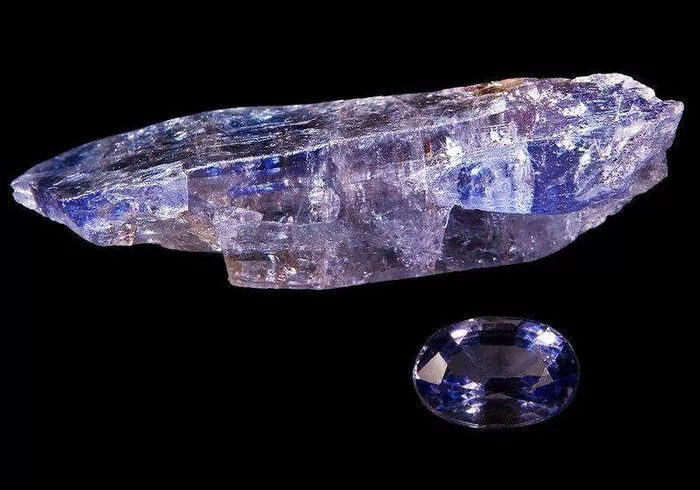Tanzanite, with its mesmerizing blue-violet hues and rarity, has captured the attention of gemstone enthusiasts and collectors worldwide. While most people are familiar with polished tanzanite gemstones set in jewelry, raw tanzanite stones offer a unique and unprocessed glimpse into the natural beauty of this remarkable gemstone. In this article, we’ll delve into the pricing of raw tanzanite stones, exploring factors that influence their value and why they are prized by gemstone connoisseurs.
Introduction to Tanzanite
Tanzanite is a rare and valuable gemstone that belongs to the zoisite mineral species. Discovered in Tanzania in the 1960s, tanzanite is renowned for its striking blue-violet color, which ranges from pale lavender to deep indigo. The unique color of tanzanite is the result of vanadium impurities within the crystal structure, which interact with light to produce the gemstone’s distinctive hue.
The name “tanzanite” is derived from its country of origin, Tanzania, where the gemstone is exclusively found. Tanzanite’s rarity and limited geographic distribution have contributed to its status as one of the world’s most sought-after gemstones. In addition to its beauty, tanzanite is also valued for its metaphysical properties, with some believing it to promote spiritual growth, calmness, and intuition.
Factors Affecting the Price of Raw Tanzanite Stones
Several factors influence the price of raw tanzanite stones, including the following:
Color: The color of tanzanite is the most significant factor in determining its value. Stones with a rich, saturated blue-violet color are highly prized and command premium prices in the market. The most desirable tanzanite stones exhibit a uniform color distribution with no zoning or color banding. Stones with lighter or less saturated colors may be less valuable, depending on the intensity of the hue.
Clarity: Clarity refers to the presence of internal characteristics, known as inclusions, within the tanzanite stone. While some inclusions are acceptable and may even enhance the stone’s beauty, high-quality tanzanite stones exhibit excellent clarity and transparency. Eye-clean stones with minimal visible inclusions are more valuable than heavily included specimens.
Carat Weight: The size of the tanzanite stone, measured in carats, also plays a significant role in determining its price. Larger stones are rarer and thus more valuable than smaller ones. However, the price per carat tends to increase exponentially as the carat weight of the tanzanite stone increases, meaning that larger stones can be significantly more expensive on a per-carat basis.
Cut: The cut of the tanzanite stone can greatly impact its beauty, brilliance, and overall value. Well-cut stones exhibit optimal proportions, symmetry, and polish, enhancing their sparkle and light performance. Popular cuts for tanzanite stones include round, oval, cushion, and emerald cuts, although other fancy shapes may also be available. A high-quality cut can maximize the stone’s color, minimize any potential color zoning or extinction, and create an attractive play of light within the gemstone.
Origin: The geographic origin of the tanzanite stone can also influence its value and desirability. Tanzanite stones from specific regions within Tanzania, such as the Merelani Hills near Mount Kilimanjaro, are highly prized for their exceptional color and clarity. Stones from these renowned sources may command higher prices in the market due to their rarity and prestige.
Raw Tanzanite Stone Price
The price of raw tanzanite stones can vary widely depending on factors such as color, clarity, carat weight, cut, and origin. In general, high-quality raw tanzanite stones with rich, saturated colors, excellent clarity, and large crystal sizes command premium prices in the market. Conversely, lower-quality stones with lighter colors, visible inclusions, or smaller sizes may be more affordable.
At the upper end of the price spectrum, rare and exceptional raw tanzanite stones with intense blue-violet hues, exceptional clarity, and large carat weights can fetch prices comparable to those of top-quality diamonds and sapphires. These stones are highly sought after by collectors, investors, and jewelry designers for their beauty, rarity, and investment potential.
On the other hand, more affordable raw tanzanite stones may be available for those with smaller budgets or less stringent quality requirements. These stones may exhibit lighter colors, more visible inclusions, or smaller carat weights but still offer the unique beauty and allure of tanzanite at a more accessible price point.
Conclusion
In conclusion, raw tanzanite stones are prized for their stunning blue-violet color, rarity, and natural beauty. The price of raw tanzanite stones can vary widely depending on factors such as color, clarity, carat weight, cut, and origin. High-quality stones with rich, saturated colors, excellent clarity, and large crystal sizes command premium prices in the market, while more affordable options may be available for those with smaller budgets or less stringent quality requirements.
Whether you’re a gemstone enthusiast, collector, or jewelry designer, raw tanzanite stones offer a unique and captivating option for incorporating the beauty of nature into your designs. With their rich history, striking color variations, and timeless appeal, raw tanzanite stones continue to captivate and inspire people around the world.


